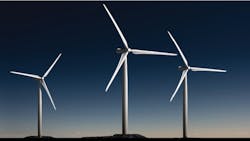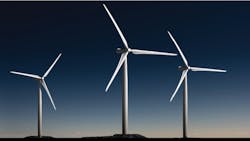Efficiency, Reliability Issues Dictate Wind Farm Performance and Profit
A recent study shows room for efficiency improvements in wind farms' electrical equipment. For instance, up to 10% of generated power is lost to heat in some transmission equipment alone. Increasing line voltage is one way to cut losses, while improved transformer design is another. Most conventional transformers works at a respectable 98% efficiency, but higher ratings are possible and desirable.
Larger conductors are one way to make transformers (see figure) more efficient. "Better yet, an improved magnetic structure allows more efficient transfer of electric fields. Transformers can be classified as grain oriented which uses traditional steel, and amorphous, a special thin metal. Grain-oriented steel is about ten-times thicker than amorphous steel," says ABB transformer design specialist Doug Getson. In a nutshell, thinner material reduces losses. Amorphous transformers cost more but they reduce no-load losses, a measure of efficiency, by 70% at times.
Related Articles
- Siemens to Provide Grid Access for World's Largest Offshore Wind Farm
- Web-based workflows boost wind farm yield
- Study Finds Storage of Wind Turbine Energy May Not Be Best
- Study says wind farms can potentially be self sustaining
- Siemens Wins Order To Connect Lincs Offshore Wind Farm to the UK Grid
- Solar and wind-gnerated power balance out, at least in some places
"Transformer losses are measured at load and no-load," says Getson. "Even when they aren't working hard, transformers are consuming power often priced from $2 to $8 per Watt over a 20 year equipment life. A 0.5 to1% boost does not sound like much but consider the many transformers on a wind farm and you suddenly see the operator could be losing a significant sum."
"Utilities often speak of a transformer's total ownership cost," says Getson. "It's the unit's price tag plus the cost of the losses." Even though more efficient transformers cost more, most utilities are learning how new designs quickly pay for themselves. For instance, a typical wind farm purchase of 80 high-efficiency transformers would cost less than $200,000 more than conventional units. Then, armed with statistical transformer workloads supplied by a wind-farm owner, each can be shown to return nearly $700/year for a total of ($700 x 80 units x 20 years =) about $1.1 million over the life of the transformer.
One way to shorten a transformers life is to ignore frequency harmonics, or stray line frequencies. "Line frequency is normally 60 Hz, but some equipment generates harmonics at five times (300 Hz) or seven times (420 Hz) the 60 Hz," says ABB's Martin. "Different equipment creates different harmonics and you have to consider the losses of the higher ones. Instead of being just 1 or 2% of voltage, it can be 20 or 30%, and such high over-voltage damages equipment." If a wind farm puts both frequencies on top of the 60 Hz, they generate heat in transformers that shortens their expected 20-year life. Filters remove some of the higher harmonics.
"Not long ago, we were seeing many different transformer specs from wind-farm owners, all intended for the same sized wind turbine. Why? We asked our engineers who design them if they were ever given specs that would identify the harmful harmonics to filter out. They were not. Harmonics were being ignored, yet it is important to know what they are because transformers were failing on wind farms and most likely because of harmonics," says Martin. If wind farm owners would share details of line irregularities with transformer manufacturers, short-transformer life may be avoided.
A second reliability issue deals with maintaining a steady line voltage. Keep it steady and the grid becomes stable and productive. "It's easier said than done, but there are several ways to do it," says Eric John, an ABB electrical engineer and director of marketing and sales. One way uses reactive power compensation.
Power on a transmission line is made of two components: active power that is measured in kWh and for which people and businesses pay, and reactive power. Suffice it to say the latter is added or removed from power to stabilize line voltage, but is not sold, so too much is wasteful.
Figure. Transformer employed in large wind farm installation.
"The cheap way to control reactive power is by switching reactors and capacitors on and offline with a mechanical switch. The drawback is that it is not smooth control and the line ends up having step changes to the voltage," says John. A wind-farm goal is to control voltage within 5 to 10% on 69 and 138 kV lines. To complicate matters, events transpire in less than a second, so a response to a power-system fault must be in less than a second. It needs an automated response, not one at a human interval.
A better way to control reactive power is with one that uses power electronics as a switch rather than a slow-acting mechanical device. Benefits? "First, this electronic switch works fast. It responds in milliseconds and it's controllable throughout its rating," says John. "These devices are rated for -40 to 50 Mvars, (reactive power). It can produce -30 Mvar and change output in less than a second to +50 Mvar, and with a smooth ramp instead of a step. It is thyristor based.
Reference
1. "Five key characteristics make wind farms more profitable," white paper by ABB.
Reprinted by permission from ABB Wind Power Solutions
About the Author

Sam Davis
Sam Davis was the editor-in-chief of Power Electronics Technology magazine and website that is now part of Electronic Design. He has 18 years experience in electronic engineering design and management, six years in public relations and 25 years as a trade press editor. He holds a BSEE from Case-Western Reserve University, and did graduate work at the same school and UCLA. Sam was the editor for PCIM, the predecessor to Power Electronics Technology, from 1984 to 2004. His engineering experience includes circuit and system design for Litton Systems, Bunker-Ramo, Rocketdyne, and Clevite Corporation.. Design tasks included analog circuits, display systems, power supplies, underwater ordnance systems, and test systems. He also served as a program manager for a Litton Systems Navy program.
Sam is the author of Computer Data Displays, a book published by Prentice-Hall in the U.S. and Japan in 1969. He is also a recipient of the Jesse Neal Award for trade press editorial excellence, and has one patent for naval ship construction that simplifies electronic system integration.
You can also check out his Power Electronics blog.

